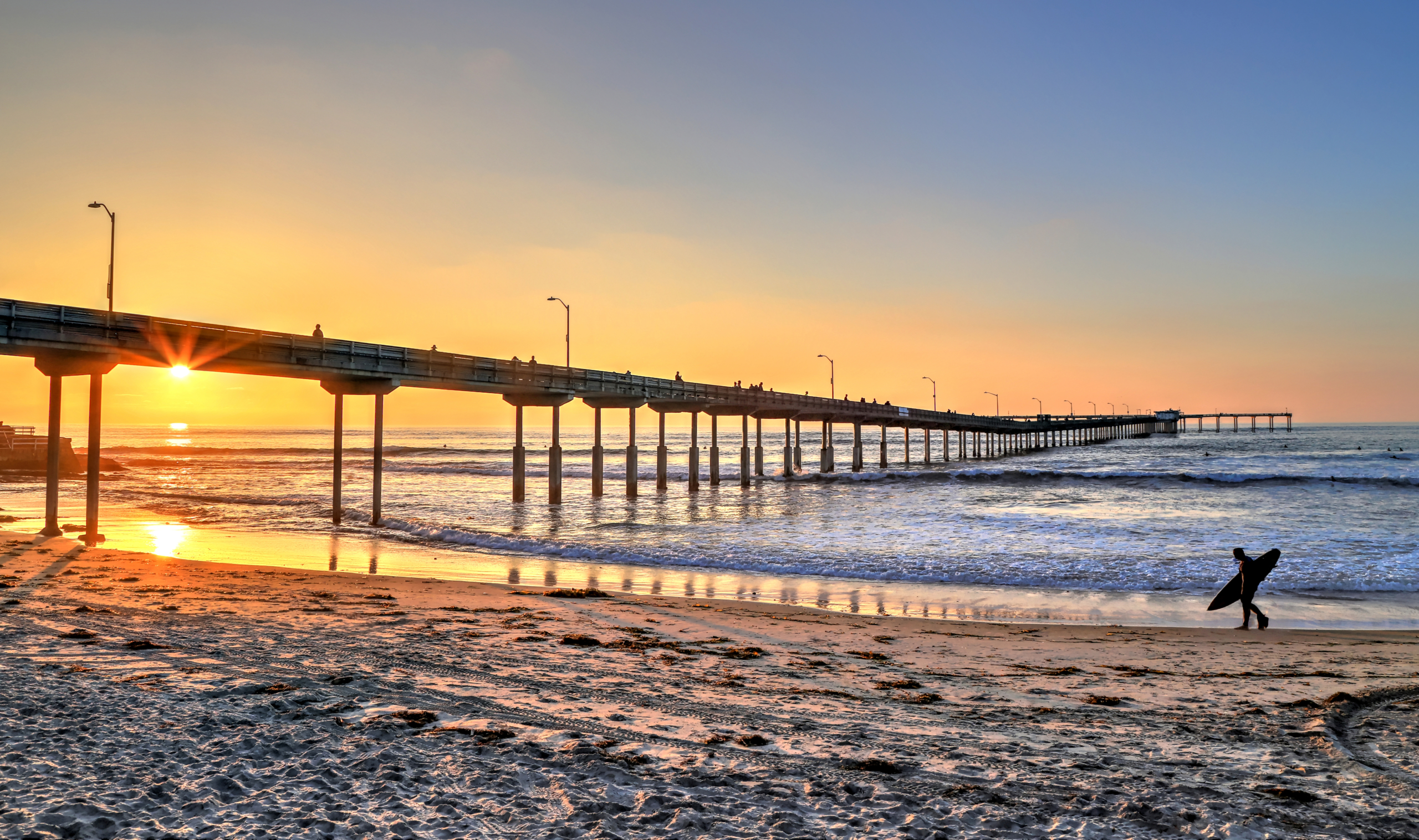San Diego

Bordered by Orange County and the Inland Empire in the north, the Mexican border in the south, Pacific Ocean to the west, deserts to the east, and blessed with an ideal climate San Diego is California’s paradise. This vibrant area is a top destination for everything from its 70 miles of sandy beaches to arts, culture and wild animals.
The second most populous county in California with over 3 million residents (2010 Census,) the San Diego area contains 16 significant naval and military locations including Marine Corps Base Camp Pendleton. Established in 1948, the Maritime Museum of San Diego is home to the largest collection of historic sea vessels in the United States. The USS Midway Museum consists of the aircraft carrier Midway and is the largest museum devoted to carriers and naval aviation.
San Diego County serves up a myriad of enticing menu options in its urban scene. The Gaslamp Quarter in the city of San Diego is considered Southern California’s premier dining, shopping and entertainment district. The Quarter is home to a truly eclectic blend of food, fun and culture all within one of San Diego’s most historic areas. San Diego’s North County boasts a variety of over 50 vineyards, from larger wineries that feature guided tours and full gift shops to small family-run places. Live music can be enjoyed at the Cricket Wireless Amphitheater, an outdoor performing arts theater in Chula Vista, the largest concert venue of its size in the San Diego area.
Optimum weather conditions and diverse landscapes-including beaches, mountains, deserts and rural back country offers a list of outdoor recreational possibilities that is virtually endless. There are more than 100 miles of breathtaking trails within the county park system. Huntington Beach features the most consistent waves on the West Coast, an attribute that helped the city receive the nickname, Surf City USA®. Huntington Beach has been consistently ranked as of the United States safest large cities. San Diego County has a freshwater system of lakes ideal for all anglers. Although trout can be snagged during the right time, largemouth bass is king here. The 90+ San Diego Golf courses scattered throughout San Diego County is the last undiscovered, very affordable, “all-around” family fun vacation spots and SERIOUS golf destinations in the U.S.A.
Popular destinations include; Mount Laguna Observatory, the San Diego Zoo and San Diego Zoo Safari Park, Sea World, Balboa Park, Legoland, Oceanside Harbor, Julian Mining Company, Anza-Borrego Desert State Park, San Diego Botanic Garden, Mission Bay Park and Mission Trails Regional Park.
HISTORY
The area which is now San Diego County was historically home to the Kumeyaay, Luiseño, Cupeño, and Cahuilla Native Americans for more than 10,000 years. Today, San Diego County has 18 federally recognized Indian reservations, more than any other county in the United States. In 1542, San Diego was the first site visited by Europeans on the west coast. Juan Cabrillo claimed the entire area for Spain, forming the basis for the settlement of Alta California 200 years later. European settlement began with the founding of the Mission San Diego de Alcalá, by Spanish pioneers, in 1769. This county was part of Alta California under the Viceroyalty of New Spain until the Mexican revolution. From 1821 through 1848 this area was part of Mexico until the Mexican-American war and the admission of California to the US. San Diego County was one of the original counties of California, and it was created at the time of California statehood in 1850. The county was named for San Diego Bay, which had been rechristened in 1602 by Sebastián Vizcaíno in honor of the Franciscan St. Didacus of Alcalá, known in Spanish as San Diego de Alcalá de Henares, and whose name was borne by Vizcaíno’s flagship. Originally San Diego County was quite large, and it included all of southern California that was south and east of Los Angeles County from the Pacific Ocean to the Colorado River. During the later part of the 19th century changes to the borders of the country created Inyo, San Bernardino, Riverside, and Imperial Counties.
GEOGRAPHY
San Diego County has a varied topography of everything from coastline to mountains to desert. The county’s 70 miles of coastline gives way to hills, mesas, and small canyons. The western third of the county is primarily urban and the northeast portion is mostly undeveloped backcountry of mountains and desert. The Santa Ana, San Jacinto, Santa Rosa, Laguna, Palomar and Viejas mountains are all part of San Diego County’s share of the Peninsular Range which runs predominantly north-south. Palomar Mountain is home to the Palomar Observatory. Viejas Mountain can be seen from parts of metropolitan San Diego. The Sonoran Desert resides to the far-east, Cleveland National Forest is spread across the central portion of the county, and the Anza-Borrego Desert State Park occupies most of the northeast. Top Picks for lake fishing in San Diego County include; Lake Cuyamaca, Dixon Lake, Lower Otay Reservior, Lake Jennings, Lake Miramar, Lake Morena, Lake Murray, San Vicente Reservoir, Chollas Lake, and Santee Lakes. El Capitan is the only reservoir that allows the use of personal watercraft, such as jetskis. Major rivers in the county include Santa Margarita, San Luis Rey, San Dieguito, San Diego, Sweetwater, and the Otay rivers.
WEATHER/CLIMATE
San Diego is one of the top-ten best climates in the Farmer’s Almanac and is one of the two best summer climates in America as scored by The Weather Channel. Under the Köppen climate classification system, the San Diego area straddles areas of Mediterranean climate to the north and Semi-arid climate to the south and east. As a result, it is often described as arid Mediterranean and Semi-arid Steppe. The climate in the San Diego area often varies significantly over short geographical distances due to different topography resulting in microclimates. Frequently, particularly during the “May gray/June gloom” period, a thick “marine layer” cloud cover will keep the air cool and damp within a few miles of the coast, but will yield to bright cloudless sunshine approximately 5–10 inland. Inland areas tend to experience much more significant temperature variations than coastal areas, where the ocean serves as a moderating influence. Thus, for example, downtown San Diego averages January lows of 50 °F and August highs of 78 °F . The city of El Cajon, just 10 miles inland from downtown San Diego, averages January lows of 42 °F and August highs of 88 °F. Rainfall along the coast averages about 10 inches of precipitation annually. The months of December through March supply most of the rain, with February the only month averaging 2 inches or more of rain. The months of May through September tend to be almost completely dry. Rainfall is usually greater in the higher elevations of San Diego; some of the higher elevation areas of San Diego can receive 11–15 inches of rain a year. Snow in the city of San Diego is so rare that it has been observed only five times in the century-and-a-half that records have been kept.





